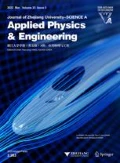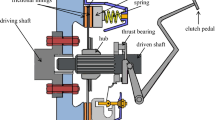Abstract
Dynamic behaviour of automotive dry clutches depends on the frictional characteristics of the contact between the friction lining material, the flywheel, and the pressure plate during the clutch engagement process. During engagement due to high interfacial slip and relatively high contact pressures, generated friction gives rise to contact heat, which affects the material behaviour and the associated frictional characteristics. In practice excess interfacial slipping and generated heat during torque transmission can result in wear of the lining, thermal distortion of the friction disc, and reduced useful life of the clutch. This paper provides measurement of friction lining characteristics for dry clutches for new and worn state under representative operating conditions pertaining to interfacial slipping during clutch engagement, applied contact pressures, and generated temperatures. An analytical thermal partitioning network model of the clutch assembly, incorporating the flywheel, friction lining, and the pressure plate is presented, based upon the principle of conservation of energy. The results of the analysis show a higher coefficient of friction for the new lining material which reduces the extent of interfacial slipping during clutch engagement, thus reducing the frictional power loss and generated interfacial heating. The generated heat is removed less efficiently from worn lining. This might be affected by different factors observed such as the reduced lining thickness and the reduction of density of the material but mainly because of poorer thermal conductivity due to the depletion of copper particles in its microstructure as the result of wear. The study integrates frictional characteristics, microstructural composition, mechanisms of heat generation, effect of lining wear, and heat transfer in a fundamental manner, an approach not hitherto reported in literature.
中文概要
目的
本研究旨在凸显热效应在离合系统动态摩擦分析 中的重要性以及将其拓展到制动系统的可能性。
创新点
采用一种未被报道过的新方法从根本上整合摩擦 特性、微结构组分、产热机理、摩擦片磨损和传 热机制。
方法
基于能量守恒原理,针对由飞轮、摩擦片和压力 板构成的离合系统提出一种适用于工业应用的热分区网络解析模型。
结论
1. 通过实测得到的μ-ν 特性表明,新的摩擦片具 有磨损片子所不具备的温度敏感性。2. 通过对磨 损片子的微结构分析以及热导率变化的测量显 示,晶格结构中铜颗粒损耗会导致其导热性能减 弱。3. 使用摩擦计的测量结果显示新的摩擦片相 对于磨损片子具有更高的摩擦系数;较高的摩擦 系数减轻了离合器啮合时产生的界面滑移的程 度,从而减小了由于产热导致的摩擦功率损耗。 4. 根据本文发展的热学模型,新的摩擦片可通过 其优良的导热性将摩擦产生的热量释放出去。
Similar content being viewed by others
References
Abdullah OI, Schlattmann J, 2013. Effect of band contact on the temperature distribution for dry friction clutch. Tribology in Industry, 35(4):317–329.
Akhtar MMJ, Abdullah OI, Schlattmann J, 2013. Transient thermoelastic analysis of dry clutch system. Machine Design, 5(4):141–150.
Arani AAA, Shahmohamadi P, Sheikhzadeh GA, et al., 2013. Convective heat transfer from a heated rotating disk at arbitrary inclination angle in laminar flow. International Journal of Engineering-Transactions B: Applications, 26(8):865–874.
Bemporad A, Borrelli F, Glielmo L, et al., 2001. Hybrid control of dry clutch engagement. Control Conference (ECC) 2001 European, p. 635–639.
Bezzazi M, Khamlichi A, Jabbouri A, et al., 2007. Experimental characterization of frictional behaviour of clutch facings using pin-on-disk machine. Materials and Design, 28(7):2148–2153. https://doi.org/10.1016/j.matdes.2006.07.001
Centea D, Rahnejat H, Menday MT, 1999. The influence of the interface coefficient of friction upon the propensity to judder in automotive clutches. Proceedings of the Institution of Mechanical Engineers, Part D: Journal of Automobile Engineering, 213(3):245–258.
Centea D, Rahnejat H, Menday MT, 2001. Non-linear multibody dynamic analysis for the study of clutch torsional vibrations (judder). Applied Mathematical Modelling, 25(3):177–192. https://doi.org/10.1016/S0307-904X(00)00051-2
Czél B, Varadi K, Albers A, et al., 2009. FE thermal analysis of a ceramic clutch. Tribology International, 42(5):714–723. https://doi.org/10.1016/j.triboint.2008.10.006
El-Sherbiny M, Newcomb TP, 1976. Temperature distributions in automotive dry clutches. Proceedings of the Institution of Mechanical Engineers, 190(1):359–365. https://doi.org/10.1243/PIME_PROC_1976_190_038_02
Gkinis T, Rahmani R, Rahnejat H, 2016. Influence of clutch lining frictional characteristics upon cold and hot take-up judder. 3rd Biennial International Conference on Powertrain Modelling and Control.
Gkinis T, Rahmani R, Rahnejat H, 2017. Effect of clutch lining frictional characteristics on take-up judder. Proceedings of the Institution of Mechanical Engineers, Part K: Journal of Multibody Dynamics, 231(3):493–503.
Glielmo L, Vasca F, 2000. Optimal control of dry clutch engagement. SAE 2000 World Congress, SAE Paper No. 2000-01-0837.
Humphrey E, Gkinis T, Morris NJ, et al., 2016. Clutch lining frictional characteristics under thermal tribodynamic conditions. 3rd Biennial International Conference on Powertrain Modelling and Control.
Khamlichi A, Bezzazi M, Parron Vera MA, 2003. Optimizing the thermal properties of clutch facings. Journal of Materials Processing Technology, 142(3):634–642. https://doi.org/10.1016/S0924-0136(03)00683-6
Lee SW, Jang YH, 2009. Frictionally excited thermoelastic instability in a thin layer of functionally graded material sliding between two half-planes. Wear, 267(9-3):1715–1722. https://doi.org/10.1016/j.wear.2009.06.037
Lienhard JH, 2013. A Heat Transfer Textbook. Courier Corporation, North Chelmsford, USA.
Marklund P, Larsson R, 2008. Wet clutch friction characteristics obtained from simplified pin on disc test. Tribology International, 41(9-3):824–830. https://doi.org/10.1016/j.triboint.2007.11.014
Menday M, Rahnejat H, 2010. Friction lining characteristics and the clutch take up judder phenomenon with manual transmission. In: Rahnejat H (Ed.), Tribology and Dynamics of Engine and Powertrain: Fundamentals, Applications and Future Trends. Woodhead Publishing Ltd., Cambridge, UK, p.680-702. https://doi.org/10.1533/9781845699932.2.680
Mills AF, 1999. Basic Heat and Mass Transfer. Pearson College Div.
Morris N, Rahmani R, Rahnejat H, et al., 2013. Tribology of piston compression ring conjunction under transient thermal mixed regime of lubrication. Tribology International, 59:248–258. https://doi.org/10.1016/j.triboint.2012.09.002
Newcomb TP, Spurr RT, 1973. Temperature as a criterion of failure in brakes and clutches. First European Tribology Congress, Proceedings of the Institution of Mechanical Engineers, p.71.
Olver AV, 1991. Testing transmission lubricants: the importance of thermal response. Proceedings of the Institution of Mechanical Engineers, Part G: Journal of Aerospace Engineering, 205(1):35–44. https://doi.org/10.1243/PIME_PROC_1991_205_235_02
Paouris L, Rahmani R, Theodossiades S, et al., 2016. An analytical approach for prediction of elastohydrodynamic friction with inlet shear heating and starvation. Tribology Letters, 64(1):10. https://doi.org/10.1007/s11249-016-0740-5
Pei YC, Chatwin C, He L, et al., 2017. A thermal boundary control method for a flexible thin disk rotating over critical and supercritical speeds. Meccanica, 52(1-2):383–401. https://doi.org/10.1007/s11012-016-0418-y
Pisaturo M, Senatore A, 2016. Simulation of engagement control in automotive dry-clutch and temperature field analysis through finite element model. Applied Thermal Engineering, 93:958–966. https://doi.org/10.1016/j.applthermaleng.2015.10.068
Quinn TFJ, 1984. The role of wear in the failure of common tribosystems. Wear, 100(1-3):399–436. https://doi.org/10.1016/0043-1648(84)90024-3
Rabeih EMA, Crolla DA, 1996. Intelligent control of clutch judder and shunt phenomena in vehicle drivelines. International Journal of Vehicle Design, 17(3):318–332.
Shah RK, Bhatti MS, 1987. Handbook of Single-phase Convective Heat Transfer. Wiley-Interscience.
Tonazzi D, Massi F, Baillet L, et al., 2015. Experimental and numerical analysis of frictional contact scenarios: from macro stick-slip to continuous sliding. Meccanica, 50(3): 649–664. https://doi.org/10.1007/s11012-014-0010-2
Yang LK, Li HY, Ahmadian M, et al., 2015. Analysis of the influence of engine torque excitation on clutch judder. Journal of Vibration and Control, 23(4):645–655.
Zhao S, Hilmas GE, Dharani LR, 2008. Behavior of a composite multidisk clutch subjected to mechanical and frictionally excited thermal load. Wear, 264(11-12):1059–1068. https://doi.org/10.1016/j.wear.2007.08.012
Author information
Authors and Affiliations
Corresponding author
Additional information
Project supported by the Technical Support of Ford Motor Company, UK
Dr. Ramin RAHMANI holds a BSc degree and also an MSc in Mechanical Engineering. He obtained his PhD in Tribology from Anglia Ruskin University in Essex, UK. He then joined Loughborough University in Leicestershire, UK as a Research Associate in 2009. His work focused on reducing internal combustion (IC) engine frictional losses through involvement in Engineering and Physical Sciences Research Council (EPSRC)-funded Encyclopaedic National Program Grant. He then became a Lecturer (assistant professor) in Dynamics and Tribology in Loughborough University in 2012 and subsequently became a fellow of higher education academy (HEA) and a Senior Lecturer (associate professor) in 2016. During this period, he was involved in a research program with International Institute for Cavitation Research (ICR) funded by Lloyd’s Register Foundation (LRF). He is currently collaborating with some major international and national industrial partners through various scientific and engineering research and enterprise grants. These collaborations are either through direct funding or are partially supported by UK funding bodies such EPSRC and InnovateUK.
Dr. RAHMANI’s research interests are in the broad field of Tribology and Dynamics with focus on enhancing energy efficiency particularly in transport systems. His research encompasses a multiphysics and multiscale approach towards the engineering problems.
Rights and permissions
About this article
Cite this article
Gkinis, T., Rahmani, R., Rahnejat, H. et al. Heat generation and transfer in automotive dry clutch engagement. J. Zhejiang Univ. Sci. A 19, 175–188 (2018). https://doi.org/10.1631/jzus.A1700481
Received:
Revised:
Published:
Issue Date:
DOI: https://doi.org/10.1631/jzus.A1700481
Key words
- Automotive clutch
- Thermal network model
- Clutch lining temperature
- Friction
- Tribometry
- Lining material properties




